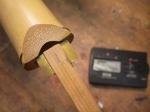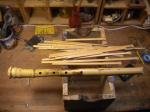Bore measuring & Ji appliance
Bore measuring & Ji appliance
Would love to hear what methods you use to Measure the bore, i have seen pictures of few measuring devices both on Mejiro and also i think i saw a picture of Perry's Measuring set somewhere.
How did you make your Measuring set and how do you use it (a few methods come to mind but never heard an actual detailed description).
My second question is how do you apply the Ji when Using Measuring technique?
Open up the bore and start sticking Ji (or another material) inside and sanding until you get close to the avg. bore Graph?
how do you apply the ji? I know you use a long stick and all but it seems pretty hard to control and build it up correctly that way, but maybe i should just try it and see how it goes...
Thanks!
Itamar
How did you make your Measuring set and how do you use it (a few methods come to mind but never heard an actual detailed description).
My second question is how do you apply the Ji when Using Measuring technique?
Open up the bore and start sticking Ji (or another material) inside and sanding until you get close to the avg. bore Graph?
how do you apply the ji? I know you use a long stick and all but it seems pretty hard to control and build it up correctly that way, but maybe i should just try it and see how it goes...
Thanks!
Itamar
Hi Itmar, Here's a couple of pics of my bore gauges.


Each are numbered for locations in the bore.
I made these with Kinya based on Chikusen Tamai's measurements. Kinya refined them to his taste. Tom Deaver, having also apprenticed under Chikusen Tamai had a similar design. I'm sure that both Kinya and Tom changed the design a bit.
As for applying Ji, it's much like plastering a wall. Not done all at once but in several stages. It's a actually quite time consuming write about. Why don't you come and visit me in New York City? I'll be glad to show you how it's done.
-Perry


Each are numbered for locations in the bore.
I made these with Kinya based on Chikusen Tamai's measurements. Kinya refined them to his taste. Tom Deaver, having also apprenticed under Chikusen Tamai had a similar design. I'm sure that both Kinya and Tom changed the design a bit.
As for applying Ji, it's much like plastering a wall. Not done all at once but in several stages. It's a actually quite time consuming write about. Why don't you come and visit me in New York City? I'll be glad to show you how it's done.
-Perry
Thanks Perry!
So you have a set for each size of flute?
I would love to come next time i will be in the states (who knows when it will happen but there is a chance that this summer if i will win a certin design contest ).
).
so its made out of wood and a metal/plastic sheet in the end?
Most Gauges ive seen so far looks like metal cylinders.
I should try make myself a set and try working on jiari this way (so far i did only bore casting with a silicone mandrel i made).
Its hard to learn all this stuff without actually working on it face to face with a teacher... i would love to take some making lessons with you if i were only able to fond the trip
maybe it will happen someday.
So you have a set for each size of flute?
I would love to come next time i will be in the states (who knows when it will happen but there is a chance that this summer if i will win a certin design contest
 ).
).so its made out of wood and a metal/plastic sheet in the end?
Most Gauges ive seen so far looks like metal cylinders.
I should try make myself a set and try working on jiari this way (so far i did only bore casting with a silicone mandrel i made).
Its hard to learn all this stuff without actually working on it face to face with a teacher... i would love to take some making lessons with you if i were only able to fond the trip

maybe it will happen someday.
"Itamar Foguel""Itamar Foguel"Thanks Perry!
So you have a set for each size of flute?
Another way to approach this is to find an old pool cue stick--they are tapered--and using a decent micrometer (good plastic ones which will measure in mm or inches are available which will suffice) measure 'slices' of the stick, then glue 3/16" wooden dowels into the wider side of the slices. You can write the msmts right onto the slices, and use them to compare your bore diameter to that of a bore profile. It's not necessary to have a separate set for each flute length; you just need a decent number of 'slices'.
For example:
http://www.amazon.com/Mitutoyo-700-126-Plastic-Digital-Caliper/dp/B001C15WF…
They can be found even cheaper than this. eBay might be a good place to look:
http://cgi.ebay.com/6-inch-LCD-Digital-Vernier-Caliper-Micrometer-Guage-New…
USD13.77 and seller ships worldwide.
Hi Kage, I do have a micrometer (caliber) buts a metal one, non digital.
I have no idea for where to get a pool cue, but i can make myself the head pieces out of pvc using a mechanical lathe.
But making it from sheets seems to be quicker, i just wonder which technique is better, and also if i make em out of pvc to what rod and how should i attach them.
I have no idea for where to get a pool cue, but i can make myself the head pieces out of pvc using a mechanical lathe.
But making it from sheets seems to be quicker, i just wonder which technique is better, and also if i make em out of pvc to what rod and how should i attach them.
"Itamar Foguel""Itamar Foguel"Thanks Perry!
So you have a set for each size of flute?
so its made out of wood and a metal/plastic sheet in the end?
Wood with metal. The sheet cut with shears, filed to size, then glued into a slit cut at the end.
Its hard to learn all this stuff without actually working on it face to face with a teacher... i would love to take some making lessons with you if i were only able to fond the trip
maybe it will happen someday.
Or, I'll make it to Israel

Répondre
